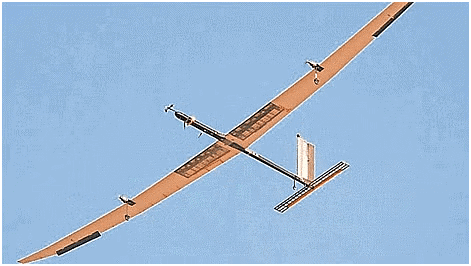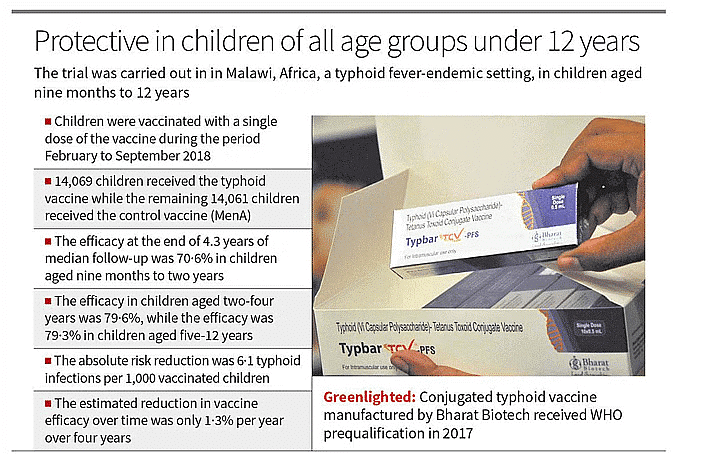Science and Technology: February 2024 Current Affairs | Current Affairs: Daily, Weekly & Monthly - CLAT PDF Download
High Altitude Pseudo-Satellite (HAPS)

Context
The National Aerospace Laboratories (NAL) in Bengaluru has successfully completed the first test of a solar-powered “pseudo satellite”, a new age unmanned aerial vehicle (UAV) that can significantly increase India’s surveillance and monitoring capabilities in the border areas.
High-altitude pseudo satellites, or HAPS, are unmanned air vehicles that can hold a fixed position. It can fly at an altitude of 18-20 km from the ground- almost double the heights attained by commercial airplanes. It has the ability to generate solar power, so it can remain in the air for months and even years-giving the advantage of a satellite.
Working of HAPS
They move at just about 80-100 km per hour at a height of 20 km above the Earth’s surface. These features help it to gauge an area for a long time. They can easily keep an eye over 200km and can observe everything even over a 400 sq km area with 5 cm resolution. It can work like a geostationary satellite and can be easily redeployed at any location with a different payload.
Challenges with operating HAPS
- Energy challenge: The primary challenge is to generate enough solar power to keep the aircraft flying, the payload operating and the batteries charging.
- Design related challenges: The aircraft should be extremely lightweight to minimize the power requirement, but it also has to be stable. That’s why this aircraft is meant to fly in the stratosphere.
- Challenges due to the stratosphere: Temperature is as low as -50 degree Celsius and even lower, which demands electronics devices to remain warm, this in turn leads to more power resources. The low density of air in this layer creates complications in producing lifts and thrust. Presence of jet streams in tropical areas also adds to challenges.
Need of HAPS
The need for development of high-endurance, high-altitude flying instruments arose from the desire to have continuous surveillance of border areas to detect changes or movements, particularly in the wake of the Doklam standoff in 2017.
Potential Benefits of HAPS
- Search and rescue missions: HAPS vehicles travel closer to the earth than satellites but can loiter locally more readily than other aircraft. This means that they are excellent tools for observation, including search and rescue missions.
- Disaster relief: HAPS vehicles can offer live situation reports and even replace failed communication networks, making them ideal for disaster relief. Interlinked HAPS vehicles offer potential advantages as they can provide services with minimal ground network infrastructure, which is ideal when a disaster is unfolding or expected to occur.
- Environmental monitoring: Continuous, real-time monitoring of environmental areas is critical to protect against natural and human threats. HAPS vehicles can fill in the gaps for environmental monitoring with a continuous flow of data with low latency. They can cover a vast area, scanning, detecting, and tracking concerns.
- Agriculture: HAPS vehicles work much like drones for agriculture, allowing monitoring and management. They again offer real-time information with reliable imagery and low latency, ensuring crops are as productive as possible.
- Maritime monitoring: HAPS vehicles are vital for surveillance, including maritime monitoring. They can be used for pollution monitoring, vessel detection, and search and rescue missions.
- Military intelligence: HAPS vehicles can collect a lot of data, which along with their wide range and high altitude, can allow for military surveillance and reconnaissance.
Countries that are involved in developing HAPS include NASA, China, South Korea, the UK, and some private companies, even in India.
India and HAPS
HAPS is still a developing technology, and the successful test flight puts India among a very small group of countries currently experimenting with this technology. A Bengaluru-based NewSpace Research and Technologies, a deep-tech start-up, flew a similar solar-powered UAV, having developed the technology through the Innovation of Defence Excellence initiative of the Defence Ministry.
CAR-T Cell Therapy

Context
CAR-T cell therapy represents a groundbreaking advancement in cancer immunotherapy. It involves modifying a patient's T cells to enhance their ability to identify and destroy cancer cells. This is accomplished through the introduction of chimeric antigen receptors (CARs) which enable T cells to specifically target antigens found on cancer cells.
How CAR T Cell Therapy Works
The process of CAR T cell therapy comprises three primary stages:
- Collection: T cells are extracted from the patient's bloodstream.
- Engineering: These T cells are genetically altered within a laboratory setting to express CARs on their surface.
- Infusion: The modified T cells are reintroduced into the patient's body, where they locate and eliminate cancer cells by recognizing distinct antigens present on their surface.
Cancer Types Treatable with CAR T Cell Therapy
Initially, CAR T cell therapy has demonstrated efficacy in treating certain blood cancers, including:
- Relapsed and/or refractory aggressive B-cell lymphomas
- Mantle cell lymphoma
- Indolent B-cell malignancies
Success Rates
Success rates of CAR T cell therapy vary depending on the type of cancer being treated. Notably, according to a study published in Nature Reviews Clinical Oncology in 2023, complete response rates were reported as:
- 40–54% for aggressive B-cell lymphomas
- 67% for mantle cell lymphoma
- 69–74% for indolent B-cell malignancies
Availability in India
As of October 2023, India's Central Drugs Standard Control Organization has approved NexCAR19, marking India's inaugural approved CART cell therapy. This regulatory approval signals a significant step forward for cancer treatment in India, opening avenues for innovative therapies.
Side Effects
While CAR T cell therapy can be highly effective, it may induce side effects, some of which can be severe. Common side effects include cytokine release syndrome (CRS), neurological effects, fatigue, fever, and heightened susceptibility to infections. Patients undergoing treatment are closely monitored to manage and mitigate these effects.
Understanding T Cells: Guardians of Immunity
T cells, also known as T lymphocytes, play a pivotal role in the body's immune response, combating infections and cancer. Originating from stem cells in the bone marrow and maturing in the thymus, T cells encompass various types, each serving distinct functions:
- Helper T Cells (Th cells): These cells aid other immune cells by releasing cytokines, orchestrating immune responses.
- Cytotoxic T Cells (Tc cells): Also referred to as killer T cells, they directly target and eliminate infected or cancerous cells.
- Regulatory T Cells (Treg cells): These cells maintain immune tolerance, preventing autoimmune reactions by suppressing inappropriate immune responses.
- Memory T Cells: After an infection, some T cells transform into memory cells, providing long-term immunity against recurring pathogens.
T Cells in CAR T Cell Therapy
CAR T cell therapy harnesses and enhances the pivotal role of T cells. By genetically modifying T cells to express CARs, they gain the ability to specifically target and eradicate cancer cells bearing particular antigens. This revolutionary approach empowers T cells to become potent weapons against cancer, leveraging the body's natural defenses in innovative ways.
The advent of CAR T cell therapy represents a significant milestone in cancer treatment, offering new hope to patients with previously untreatable conditions. As research continues and technology advances, the potential of immunotherapy in combating cancer grows ever more promising. SRIRAM's commitment to disseminating knowledge underscores the importance of staying informed and engaged in the ongoing evolution of medical science.
India’s Ambitious Push for Deep Tech

Context
A note on a new ‘deep tech’ policy for India will be sent for Union Cabinet approval in the coming weeks.
- A draft of the policy on Deep Tech has been released In July 2023, for public comment and following feedback from the industry, a final version is ready for approval.
Key Features of National Deep Tech Startup Policy (NDTSP)
- Aim:
- To propel innovation, economic growth, and societal development and
- To lay the foundation for India’s emerging Deep Tech Startup ecosystem.
- Pillars:
- Ensuring the Security of India’s Economic Future
- Facilitating a Seamless Transition to a Knowledge-Driven Economy
- Bolstering National Capability and Sovereignty through the Atma Nirbhar Bharat Imperative
- Fostering Ethical Innovation.
key Foundational Elements of the Policy
- Funding and Innovation: The strategy attempts to give financial assistance to deep tech firms through a variety of means such as grants, loans, and venture capital.
- It also aims to foster innovation by simplifying regulatory processes and encouraging collaboration between academia and industry.
- Talent Development: It promotes steps to cultivate a skilled workforce in the deep tech sector. This includes promoting STEM education, offering training possibilities, and attracting international talent.
- The policy also provides for the creation of domain expertise for data interpretation through a fee-service model.
- Access to Advanced Infrastructure and Technology: It suggests that deep tech incubation centers and testing facilities be established across the country, it also emphasizes strengthening the existing tie-ups with IIT and IISc, etc to provide shared infrastructure resources at nominal fees.
- Public Procurement and Market Opportunities: The strategy pushes government agencies to embrace deep-tech solutions and opens up new markets for businesses as well as become the first market for such deeptech startups. It also encourages international cooperation and market access.
- Intellectual Property (IP) Protection: It suggests the establishment of a uniform IP framework and the implementation of strong cybersecurity measures.
Typbar Typhoid Vaccine
Why in News?
Recently, phase-3 trial conducted in Malawi, Africa, a region endemic for typhoid fever, has demonstrated the long-term efficacy of Bharat Biotech’s Typhoid conjugate vaccine (TCV), Typbar. The efficacy of the vaccine was seen in children of all age groups studied.
- Typbar TCV is the world's first clinically proven conjugate Typhoid vaccine.
What are the Major Findings of the Typbar Vaccine Trials?

What is Typhoid?
- About: Typhoid fever is a life-threatening infection caused by the bacterium Salmonella Typhi. It is usually spread through contaminated food or water.
- It is transmitted by the faecal-oral route, through ingestion of contaminated food or water.
- Once the bacteria is ingested, it multiplies and spreads into the bloodstream.
- Urbanisation and climate change have the potential to increase the global burden of typhoid.
- Symptoms: It encompasses fever, fatigue, gastrointestinal problems, headache, and occasionally a rash.
- Severe cases can result in complications or death, confirmed through blood testing.
- Risk Factor and Disease Burden: In 2019, there were an estimated 9.24 million typhoid cases and 1,10,000 deaths across the world.
- It remains a significant health issue, particularly in developing regions. The majority of the typhoid cases and deaths in 2019 occurred in South-East Asia and Africa.
- Lack of safe water and sanitation heightens risk, especially for children.
- Treatment: Antibiotics are the mainstay of treatment, but increasing resistance to antibiotic treatment is making it easier for typhoid to spread in communities that lack access to safe drinking water or adequate sanitation.
- The existence of resistant strains of bacteria means antibiotics or drugs designed to kill them no longer work, allowing them to spread rapidly, posing a risk to public health.
- Prevention: Prevention strategies include access to safe water, sanitation, and hygiene.
- WHO recommends integrating typhoid conjugate vaccines to routine childhood immunisation programmes in typhoid endemic countries.
- Gavi supports vaccine implementation in eligible nations.
- The Vaccine Alliance (GAVI) was set up as a Global Health Partnership in 2000 with the goal of creating equal access to new and underused vaccines for children living in the world’s poorest countries.
- At the Global Vaccines Summit in June 2020, India pledged USD 15 million for Gavi’s 2021–2025 programme.
Green Propulsion System

Context
A Green Propulsion System, developed under the Technology Development Fund (TDF) scheme of DRDO, has successfully demonstrated in-orbit functionality on a payload launched by PSLV C-58 mission.
Details
The project, known as "1N Class Green Monopropellant thruster for altitude control and orbit keeping of micro satellite," was entrusted to Bellatrix Aerospace Pvt Ltd, a Bengaluru-based start-up, serving as the development agency.
Key Achievements
- Telemetry Data Validation: The Telemetry Data from the PSLV Orbital Experimental Module (POEM) at the ISRO Telemetry, Tracking and Command Network (ISTRAC) in Bengaluru has undergone rigorous validation against ground-level solutions. The system has not only met but surpassed all performance parameters.
- Non-Toxic and Environment-Friendly: The Green Propulsion System is a groundbreaking technology that provides a non-toxic and environmentally friendly propulsion system suitable for low orbit space missions.
- Indigenous Components: The system comprises various indigenously-developed components, including Propellant, Fill and Drain Valves, Latch Valve, Solenoid Valve, Catalyst Bed, Drive Electronics, among others.
- Ideal for High Thrust Requirements: This innovation is deemed ideal for space missions with high thrust requirements, showcasing versatility in addressing the diverse needs of space exploration.
Technology Development Fund (TDF)
- The TDF is a flagship programme of the Ministry of Defence, spearheaded by DRDO, aligning with the 'Make in India' initiative.
- This program focuses on funding innovation in defence and aerospace, with a particular emphasis on supporting start-ups and Micro, Small & Medium Enterprises (MSMEs).
- The success of the Green Propulsion System further underscores the effectiveness of such initiatives in pushing the boundaries of technological advancements in the realm of space defence.
Understanding Propulsion Technology
- Propulsion Technology refers to the means by which an object is propelled or driven forward.
- In the context of rockets and airplanes, propulsion is achieved through the application of Newton’s third law, stating that for every action, there is an equal and opposite reaction.
- In essence, a working fluid or gas is used to accelerate the engine, providing the necessary thrust for movement.
Green Propulsion Technology by ISRO
- The Indian Space Research Organisation (ISRO) embarked on the development of Green Propulsion Technology in 2018, aiming to create environmentally friendly alternatives for propellants.
- Key milestones in ISRO's Green Propulsion endeavors include:
- Eco-Friendly Solid Propellant: ISRO developed an eco-friendly solid propellant consisting of Glycidyl Azide polymer (GAP) as fuel and Ammonium Di-Nitramide as the oxidizer in 2018.
- Testing Various Combinations: ISRO engaged in technology demonstration projects involving green propellant combinations, such as kerosene, Hydrogen Peroxide, Liquid Oxygen, AND-Glycerol-water, AND-Methanol-water.
- Liquid Oxygen and Hydrogen Propulsion Systems: ISRO initiated testing of propulsion systems based on Liquid Oxygen and Liquid Hydrogen for launch vehicles, expanding the scope of green propulsion technologies.
- ISORENE Development: ISRO introduced ISORENE, a rocket-grade version of kerosene, as an alternative to conventional Hydrazine rocket fuel.
- Electric Propulsion System: ISRO successfully demonstrated the Electric Propulsion system in the South Asia Satellite (GSAT-9) launched in May 2017. This technology offers enhanced efficiency and control.
Types of Propulsion Systems in Satellites
Chemical Propulsion
- Bi-Propellant Systems:
- Utilize two separate propellants that combine in a combustion chamber.
- Common propellant combinations include liquid oxygen (LOX) and hydrazine.
- Mono-Propellant Systems:
- Use a single propellant that decomposes exothermically to produce thrust.
- Hydrogen peroxide is a common choice for mono-propellant systems.
Electric Propulsion
- Ion Thrusters:
- Expel ions at high speeds using electric or magnetic fields.
- Ideal for long-duration missions due to high specific impulse.
- Hall Effect Thrusters:
- Accelerate plasma using magnetic fields.
- Balances thrust and efficiency, suitable for station-keeping and orbit adjustments.
Green Propulsion
- Water Electrolysis Propulsion:
- Utilizes water as a propellant, separating it into hydrogen and oxygen through electrolysis.
- Environmentally friendly and suitable for small satellites.
- Green Mono-Propellants:
- Focuses on developing non-toxic, environmentally friendly mono-propellants.
- Aims to reduce the environmental impact of satellite propulsion.
Applications of Propulsion Systems in Satellites
- Orbit Insertion: Chemical propulsion is commonly used during launch to insert satellites into their designated orbits.
- Station-Keeping: Electric propulsion systems help satellites maintain their positions in geostationary or other orbits.
- Collision Avoidance: Propulsion systems enable satellites to adjust their orbits to avoid collisions with space debris or other satellites.
- End-of-Life Maneuvers: Satellites use propulsion systems to deorbit and perform end-of-life maneuvers to reduce space debris.
Nano DAP

Context
In the recent interim budget presentation, the Finance Minister of India announced the broadening of Nano DAP's usage across diverse crops in all agro-climatic zones.
 |
Download the notes
Science and Technology: February 2024 Current Affairs
|
Download as PDF |
About Nano DAP
- It is a unique liquid fertilizer product that contains nanoparticles of Diammonium Phosphate (DAP).
- It is a source of nitrogen and phosphorus – 2 key primary nutrients essential for the growth of crops.
- It contains 8% Nitrogen and 16% Phosphorus by volume.
- Unlike conventional DAP, which comes in granular form, IFFCO’s Nano DAP is in liquid form.
- It has an advantage in terms of surface area to volume, as its particle size is less than 100 Nanometre (nm).”
Advantages of NANO DAP
- Higher Crop Yield: Due to small size and more surface area to volume ratio; seed treatment and foliar application of Nano DAP at critical growth stages enhances nutrient availability to crops.Hence, Crop yield increases due to increase in leaf chlorophyll, photosynthesis, root biomass, number of effective tillers and branches.
- Quality Food: Nutritional quality of harvested food produce was found to be better in terms of protein and nutrient content.
- Reduction in Chemical Fertilizer Usage: Enhanced use efficiency of one bottle (500 ml) of Nano DAP can potentially replace the phosphorus requirement met by conventional DAP by 50%.
- Environment Friendly: Production of Nano DAP is energy and resource friendly. Precision and targeted application of this to crops therefore leads to agriculture sustainability and safety of the environment by reducing soil, air and water pollution.
- It is more pocket-friendly than its conventional counterpart.A 500 ml bottle of Nano DAP, equivalent to a 50-kg bag of conventional DAP
- It is set to significantly reduce this import burden.
What is DAP?
- DAP, or di-ammonium phosphate, is the second most commonly used fertilizers in India after urea.
- It is high in phosphorus (P) that stimulates root establishment and development — without which plants cannot grow to their normal size, or will take too long to mature.
Conserving Northern White Rhino Through Surrogacy

Context
The northern white rhino (NWR) is one of the most endangered animals on the planet, with only two females left alive. In a bid to rescue this species, scientists embarked on an ambitious project named BioRescue in 2015, employing reproductive technologies like in-vitro fertilization (IVF) and stem cell techniques.
Recently, the international consortium, BioRescue, announced the first-ever rhino pregnancy through a lab-made embryo transferred to a southern white rhino. This endeavor represents a beacon of hope for the survival of the northern white rhino.
How are Scientists Creating Test Tube Rhinos?
- In-Vitro Fertilization (IVF) Breakthrough: BioRescue, an international consortium of scientists, achieved a historic milestone with the first-ever rhino pregnancy through IVF. The process involved transferring a lab-made rhino embryo into a surrogate southern white rhino.
- Surrogacy: The death of the last male northern white rhino in 2018 made surrogacy the only viable option for species regeneration. The remaining two females, Najin and Fatu, were found incapable of reproduction for pathological reasons. The only hope for the NWR is to use frozen sperm from deceased males and eggs from the females to create embryos in the laboratory, and then implant them into surrogate mothers from the southern white rhino (SWR) subspecies, which is more abundant and genetically similar.
Concerns Regarding the Test Tube Rhinos
- Genetic Viability Concerns: Embryos used in the process are derived from eggs of two females and sperm from deceased males, limiting the gene pool for a viable northern white population.
- Preserving Northern White Rhino Traits: Crossbreeding with southern white rhinos is not a solution, as it would result in the loss of unique attributes of the northern white, adapted for swampy habitats. Genetic diversity remains a concern even with successful IVF and surrogacy attempts.
- Behavioral Challenges in IVF Offspring: Babies born through IVF are not genetically hardwired to exhibit typical northern white rhino behaviors. Early interaction and learning from northern white adults are crucial for maintaining species-specific traits.
- The urgency lies in the age of the remaining northern white females, Najin (35) and Fatu (24). To ensure behavioral and social skills are passed on, the first IVF calves must be born in time to learn from the surviving females.
- Conservation Beyond Test Tubes: Critics argue that the focus should not only be on species regeneration but also on addressing the root causes of extinction, such as habitat threats and poaching.
- Surrogacy: It is an arrangement in which a woman (the surrogate) agrees to carry and give birth to a child on behalf of another person or couple (the intended parent/s). A surrogate, sometimes also called a gestational carrier, is a woman who conceives, carries and gives birth to a child for another person or couple (intended parents).
What are the Key Facts Regarding the Northern White Rhino?
- About: The NWR is a subspecies of the white rhino (Ceratotherium simum), which is native to central and eastern Africa. White rhinos are the second largest land mammal after the elephant. They are known as the square-lipped rhinoceros; white rhinos have a square upper lip with almost no hair. The northern and southern white rhino are two genetically distinct subspecies of the white rhino.
- Current Status: The IUCN Red List Status of White Rhino is Near Threatened. The IUCN status of its subspecies is as follows: Northern White Rhino: Critically Endangered. Southern White Rhino: Near Threatened. The NWR population has declined dramatically due to poaching, habitat loss, civil war, and disease. In the 1960s, there were about 2,000 NWRs in the wild. By 2008, only four remained.
- The last male NWR, named Sudan, died in 2018, leaving only two females, Najin and Fatu, who live in a conservancy in Kenya. The majority (98.8%) of the southern white rhinos occur in just four countries: South Africa, Namibia, Zimbabwe, and Kenya. Southern white rhinos are around 18,000 animals that exist in protected areas and private game reserves.
End-to-end Encryption
Context
This article explores End-to-end encryption (E2E), detailing its operational mechanisms and examining implementation challenges and complexities.
What is End-to-end encryption (E2E)?
- Encryption serves as a method to safeguard data against unauthorized access or manipulation.
- It functions by converting the data into a confidential code that only the designated recipient can decode. This proves beneficial in numerous scenarios, including securing online correspondence, safeguarding sensitive data, and authenticating digital identities.
- Encryption primarily falls into two categories:
- Symmetric: This method employs a single key for both encryption and decryption. In symmetric encryption, the key utilized to encode data is identical to the one needed for decoding it.
- Asymmetric: Asymmetric encryption relies on a pair of keys: a public key and a private key. The public key can be distributed openly, whereas the private key must remain confidential.
- The concept of encryption typically pertains to safeguarding stored data, whereas end-to-end encryption ensures the protection of data during its transmission between locations, particularly in scenarios involving rapid information exchange.
- In an application equipped with end-to-end encryption (E2EE), only the individuals at each end—namely, the sender and recipient—have the ability to access exchanged messages.
What are the issues with End-to-end encryption (E2E)?
- Compromised endpoints: If either endpoint has been compromised, an attacker may be able to see a message before it is encrypted or after it is decrypted. Attackers could also retrieve keys from compromised endpoints.
- Too much privacy: Government and law enforcement agencies express concern that end-to-end encryption can protect people sharing illicit content because service providers are unable to provide law enforcement with access to the content.
Brainoware

Context
Recently, scientists have seamlessly integrated brain-like tissue with electronics to create Brainoware, an 'organoid neural network (ONN)' capable of recognizing voices and solving complex mathematical problems. This innovative system extends neuromorphic computing to a new level by directly integrating brain tissue into a computer.
What is Brainoware?
- About: Brainoware is an innovative computing system that melds brain-like tissue with electronics. It integrates brain organoids with microelectrodes, forming an 'organoid neural network (ONN)' that directly incorporates living brain tissue into the computing process.
- Brain Organoids: These are 3D tissues that simulate the structure and function of the human brain. Derived from human embryonic stem cells, they can self-organize and reflect the brain's developmental process. They serve as models to study human brain development and diseases.
- ONNs: Unlike artificial neural networks made of silicon chips, ONNs use biological neurons capable of adaptation and learning from the environment.
- Operational Mechanism:
- Three-Layered Architecture: Input, Reservoir, and Output
- Input Signals Processing: Electrical stimulation is processed through ONNs.
- Reservoir: Converts signals into mathematical entities for efficient computer processing.
- Output Readout: Interprets Brainoware's neural activity to provide tangible results.
Advantages over Traditional Neuromorphic Computing
- Memory and Processing Separation: Unlike traditional neural networks, Brainoware integrates memory and data processing units, leading to lower energy consumption.
- Biological Neural Network Integration: Brainoware utilizes live brain cells, reducing energy demands compared to AI hardware.
Challenges and Considerations
The system faces challenges such as technical expertise and infrastructure maintenance. Ethical concerns about the consciousness of organoids and their mechanistic use also arise.
Future Prospects
Continued study of the 'organoid neural network' could provide insights into learning mechanisms, neural development, and cognitive implications of neurodegenerative diseases. It could contribute to neuroscience and medical research, bridging tissue engineering, electrophysiology, and neural computation.
Radiocarbon Dating
Context
The technique called radiocarbon dating brought the first verifiable way to do this to many fields of science, transforming them – and our world – to a significant degree.
About Radiocarbon dating
Dating is a method by which the age of an object can be determined. Radiocarbon dating refers to a method that does this using radiocarbon, a name for the isotope carbon-14.
- It is created in the earth’s atmosphere when cosmic rays – energetic streams of charged particles coming from sources in outer space – slam into the atoms of the gases and release neutrons.
- When these neutrons interact with the nitrogen-14 nitrogen isotope, they can produce carbon-14.
- Since cosmic rays are ceaselessly passing through the earth’s atmosphere, carbon-14 is created constantly there.
- It is readily combined with atmospheric oxygen to form radioactive carbon dioxide.
- This compound then enters the bodies of plants (via photosynthesis), animals (when they consume plants), and other biomass through the carbon cycle.
- It is in the form of carbon dioxide and other carbon compounds, would have to be able to diffuse into the earth’s various ecosystems such that the concentration of carbon-14 in the atmosphere was comparable to the concentration of carbon-14 in the planet’s other biospheres.
How does radiocarbon dating work?
- When an organic entity – like the human body – is ‘alive’, it constantly exchanges carbon with its surroundings by breathing, consuming food, defecating, shedding skin, etc.
- Through these activities, carbon-14 is both lost from the body as well as replenished, so its concentration in the body is nearly constant and in equilibrium with its surroundings.
- When this individual dies, the body no longer performs these activities and the concentration of carbon-14 in the body begins to dwindle through radioactive decay.
- The more time passes, the more the amount of carbon-14 lost, and the less there will remain. This decay rate can be predicted from theory.
- Radiocarbon dating dates an object by measuring the amount of carbon-14 left, which scientists and/or computers can use to calculate how long ago the body expired.
- The modern radiocarbon dating setup is more sophisticated and one of the most sensitive dating setups uses accelerator mass spectrometry (AMS), which can work with organic samples as little as 50 mg.
|
1097 docs|745 tests
|
FAQs on Science and Technology: February 2024 Current Affairs - Current Affairs: Daily, Weekly & Monthly - CLAT
| 1. What is a High Altitude Pseudo-Satellite (HAPS)? |  |
| 2. How does CAR-T Cell Therapy work? |  |
| 3. What is India's Ambitious Push for Deep Tech? |  |
| 4. How does the Typbar Typhoid Vaccine work? |  |
| 5. What is a Green Propulsion System? |  |




























